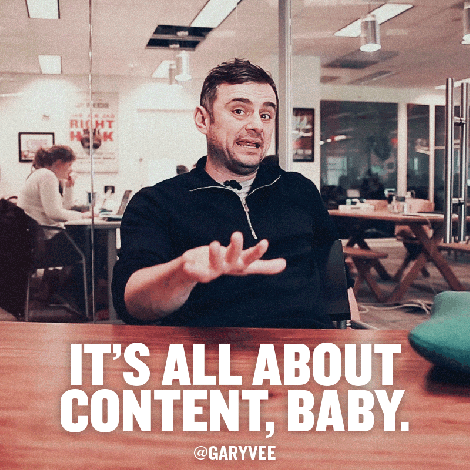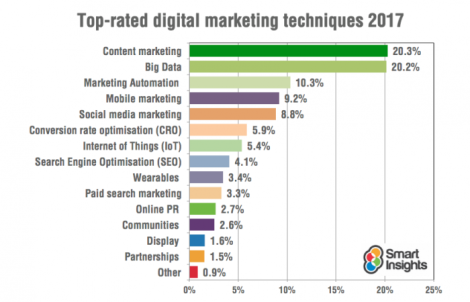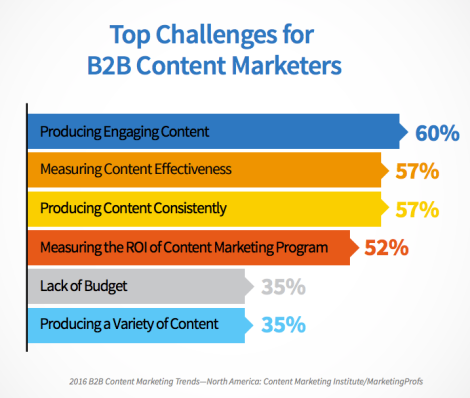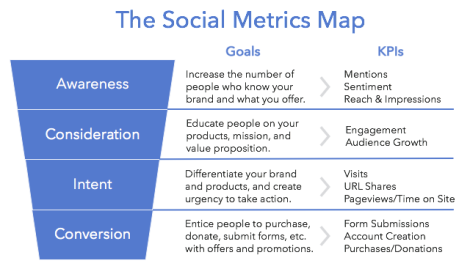Before I get into the nitty gritty of how to create such a strategy, I want to give you a compelling reason why you need to make Content Marketing an integral part of your marketing budget.

Consider this statistic highlighted courtesy of Lenati
67% of the typical B2B buyer’s journey is now done digitally, and 9 out of 10 B2B buyers say online content has a moderate to major effect on their purchasing decisions.”
Even though this statistic is based on a B2B consumer I have no doubt that the outcome would be the same for a B2C buyer. Why?
The consumer whether B2B or B2C is intelligent, protective of their privacy, does not want to compromise on quality, expects a personalised user experience and above all now conducts their own research before considering making an enquiry.
Gone are the days of someone blindly engaging with a sales rep and this very point is encapsulated in this piece of research from the Demand Gen Report – Content Preferences Survey which states that:
47% of buyers viewed three to five pieces of content before engaging with a sales rep.”
At the end of the day, while increased website traffic, increasing impressions and lots of social shares are positive, a business will only survive if it can turn casual visitors into advocate customers.
Therefore, a business needs to employ tactics and use strategies that will motivate and increase the chances your target audience will want to do business with you, and Content Marketing, done well, is just such a strategy in my opinion.
Business Is Buying Into Content Marketing
In 2017 Content Marketing is appearing to be now seen as an integral and vital part of a company marketing strategy. This is very well evidenced by an excellent survey done by Smart Insights who asked their readers the following question.
“Select one marketing activity that you think will give your business the biggest incremental uplift in leads and sales in 2017 (or your clients if you work for an agency or as a consultant).”
Out of 2,352 responses Content Marketing was polled at the top as illustrated by the image below courtesy of Smart Insights

Content Marketing Is Becoming Universally Accepted
In 2016, 90% of businesses were implementing Content Marketing as a tactic in their business and for 2017 it is estimated that this figure will increase according to this report by the leading authority in the area of Content Marketing The Content Marketing Institute
They define Content Marketing as follows:
Content marketing is a strategic marketing approach focused on creating and distributing valuable, relevant, and consistent content to attract and retain a clearly defined audience — and, ultimately, to drive profitable customer action.”
This is a very clear definition of what Content Marketing is and when you think about it makes perfect sense.
Customers, buyers and prospects in 2017 are more sales savvy, knowledgeable about what it is they want and are intent on doing their own intensive research when trying to find an answer or a solution.
Therefore, it stands to reason that if a company provides quality information that is relevant to their audience that allows them come to a decision easier, than the company in question should see positive results.
But this not the case!
Businesses Are Struggling To Get Success With Content Marketing
Even though Content Marketing makes sense and companies understand the benefits that can be accrued from employing such a strategy, businesses are struggling to get the success they want.

If I go back to the headline of this post titled:
How To Create The Best Content Marketing Strategy
I do believe that a number of these challenges could be tackled and the results improved if companies reviewed what they had defined as their Content Marketing Strategy.
Consider these core statistics for a moment:
70% of marketers lack a consistent or integrated content strategy. (Altimeter)
80% of B2B marketers have a content marketing strategy. 32% documented 48% not
Having a detailed documented strategy that is consistently applied, reviewed and iterated where and when necessary, is a crucial element that based on the above results a lot of companies are failing to do which then feeds into the issues and struggles that I alluded to earlier.
In their 2016 Content Marketing Benchmark report The Content Marketing Institute in conjunction with Marketing Profs found a number of challenges (see image courtesy of Smart Insights below) that businesses reported when trying to get traction with Content Marketing.

Step 1 Define Your Goals
This invariably is the most critical step. If you don’t know why you are undertaking Content Marketing and what is it that you want to achieve from your Content Marketing activities you will struggle to see any real traction or benefits accrued. You may in fact do damage to your brand as you come across confused and inconsistent in both messaging and communications.
When defining goals when it comes to Content Marketing I believe you have to do it with your end customer in mind and based on the stage of the sales journey they could be on with you.
Simply Measured did an excellent job to flesh this out and how you need to create content that has a purpose. From this article they put forward an excellent content funnel (see image below) where they mapped content against the traditional sales funnel journey a person would travel.

I think the above map would be an excellent overlay to allow a company develop very personalised and relevant objectives for the various tactics that would be employed as a prospect moved closer to conversion.

Step 2 Persona Research
Knowing and understanding what your customer and the target market pain points, needs and wants are is crucial so that you can align your message tailored to what will peak their interest.
Hubspot outline a very detailed plan to begin creating your customer personas but a core element is you have to conduct your research on the market and use insights from customer surveys, reviews, interviews from your sales team etc.
Every customer and prospect is looking for a solution or an answer, but the core interest or element that they deem critical in order for them to make a decision is vital to know.
For example some customers maybe price focussed, others look for testimonials and proof of delivery. Once you can identify these you can then better craft your message to resonate with them.

Step 3 Content Audit
A lot of companies have produced lots of content yet it gets forgotten in place of yet another campaign.
You must review what has been done before, how did it perform, did it work, did it not, why did work, why did it fail, could it be used again, updated etc.
Looking at what the company has initially produced and reviewing how it performed the first time will provide not only potential content for the new strategy, but doing this review will yield critical performance information to ensure mistakes that happened the last time don’t occur again.

Step 4 Content Management
You need to document and agree a system for creating the content, publishing the content and then reviewing how it performs against your objectives and KPI’s.
For example if the company decides that a blog will be a core content tactic to be used, will this be managed via wordpress or an alternative solution, or will you decide to have one all encompassed approach that allows for content marketing, analytics and CRM to be contained in one bespoke piece of software such as Hubspot.

Step 5 Content Brainstorming
While this is down as a step it will not be a once off action.
Setting up agreed idea generation meetings is a necessity to allow for new ideas or the iteration and improving of original content previously shared with the market.
At these sessions you need to agree what types of content should be produced and for blog posts using a blog post title generator like this one from Hubspot is valuable.
Ultimately though at these sessions you are looking to come up with ideas and solidify the core content you wish to create as part of your content strategy.
Some excellent forms of content that could be created are as follows:
- Blog
- Ebooks
- Whitepaper
- Industry Report
- Infographic
- Video
- Tips sheet
- Templates
- Podcast
- Quotes
- FAQ’s

I placed a blog at the top because I truly believe that it is a content marketing tactic that is mandatory for the majority of companies.
Not only does having a blog help in the long term with SEO and page-rank, but it allows you showcase your expertise to your market and the beauty of a blog is that a post or multiple posts under the same theme could be repurposed into any of the other content forms listed above.

6 Content Planning
Creating a plan around an editorial calendar is critical from a Content Marketing point of view. You need to work towards having your content designated for a certain audience and then scheduled to post and be distributed at key periods ahead of time rather than try to do it live on the due date.
An editorial calendar allows you plan what content should go on what date against each of the social channels, and it can also allow you forward look at specific events or seasonal times like Easter or Christmas where if applicable, you can ahead of time create content specific to that event, and hence, become more relevant and on topic in the face of your audience.

7 Unlock Influencer Relationships
A lot of companies fall into the trap that because they are “the company” they see themselves as automatically being an influencer in the market. While that may be true of some of the large brands it is not a given.
In many industries from tech to food to fitness there are individuals who have built up a follower base of raving fans who live and breathe every word and piece of content that these people promote.
However, I would never advocate to any company or individual that they go down the influencer route by purely paying for an influencer to endorse or promote their company or product to their audience.
I believe in creating genuine relationships with influencers where there is mutual respect and support for what each other is doing by building a trusted relationship built on transparency from which the benefits that can be created are very positive for everybody.

8 Promotion
One of the biggest mistakes both individuals and companies make when it comes to Content Marketing is the area of promotion. For example with a blog post a lot of bloggers and companies will simply post the blog once and forget about it.
However promotion and multiple publishing is key to ensure that as large a segment of your audience gets to see a piece of content.
This is yet another reason to have an editorial calendar where reposting of content at set times across various mediums from email to social can be utilised.
Conclusion
Content Marketing is becoming an integral part of every company’s marketing strategy, but I do believe that a lot of the struggles that companies are facing with their own Content Marketing as identified in the research is down to the fact that either there is no documented strategy in place, or at best they are using a very loose plan.
For it to work it needs to have its own detailed plan that is linked into the overall strategy for the business. You need to set a budget to ensure your Content Marketing can properly work towards achieving the objectives set, you will need to actively measure and monitor results of how content is performing and iterate or change as required, and above all you need to have patience.

Apart from having no documented strategy I believe the number one reason why a lot of companies struggle for content success is that they don’t have patience and expect it to be an instant win.
Unfortunately this is not the case and I always advise a client that at minimum you need to allow for 6 months of consistent activity before you could see any traction.
This is where Marketing and Finance can come to blows as return on investment is questioned.
However, building awareness, reputation, expertise and trust takes time. If you commit to it and focus on aligning your content against the requirements of the target audience at the right stage of the content funnel, I honestly believe you will seriously increase the likelihood of taking that prospect from intent to conversion.
About the author

Hi, my name is Phillip Twyford and as someone who has worked in marketing for over 20 years, I fell in love with social media especially as a medium for communicating with businesses of all sizes. If you want to know more visit me at www.thecurlymarketer.com
Follow Phillip
YouTube | Twitter | Facebook | Instagram
